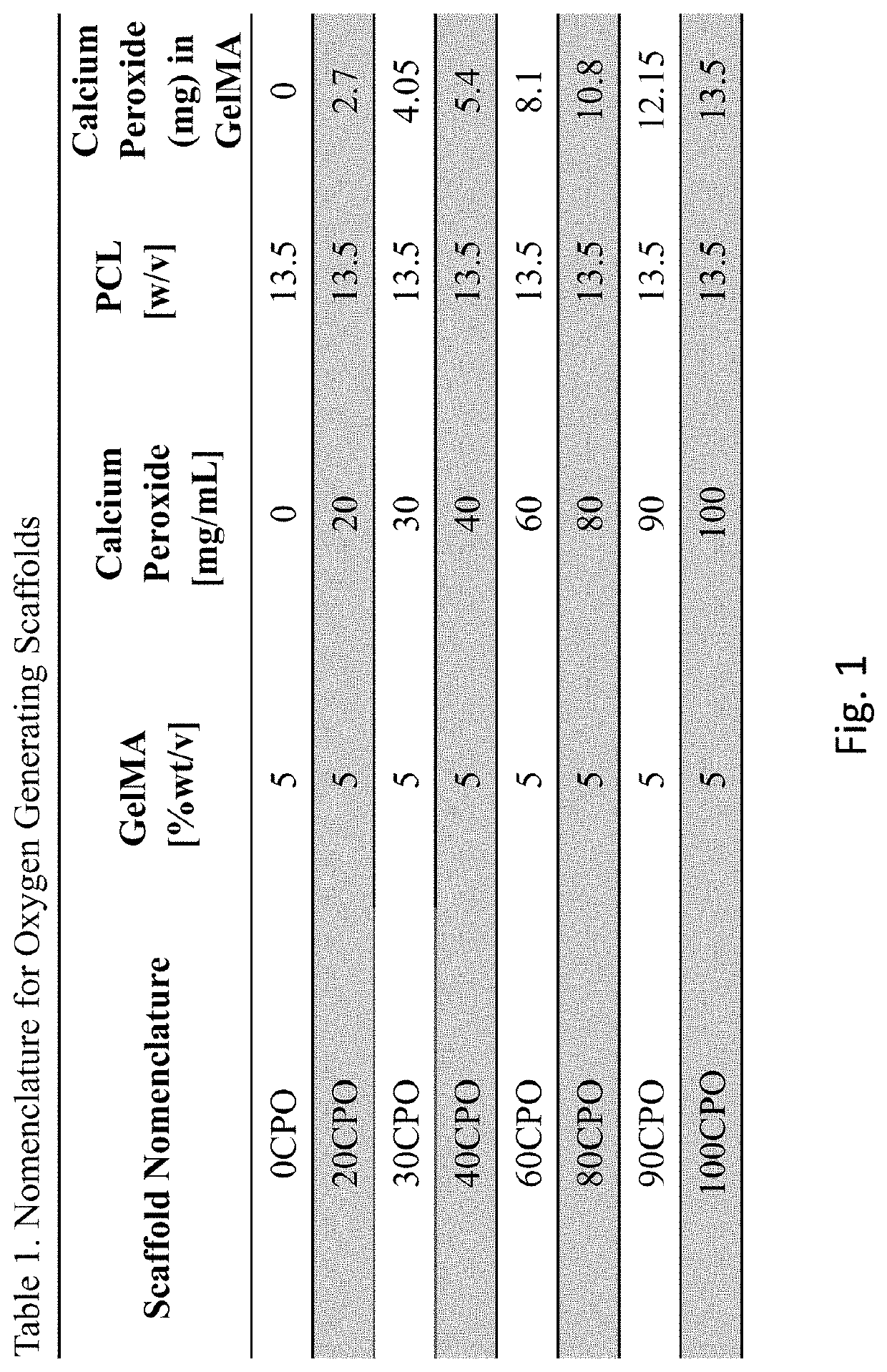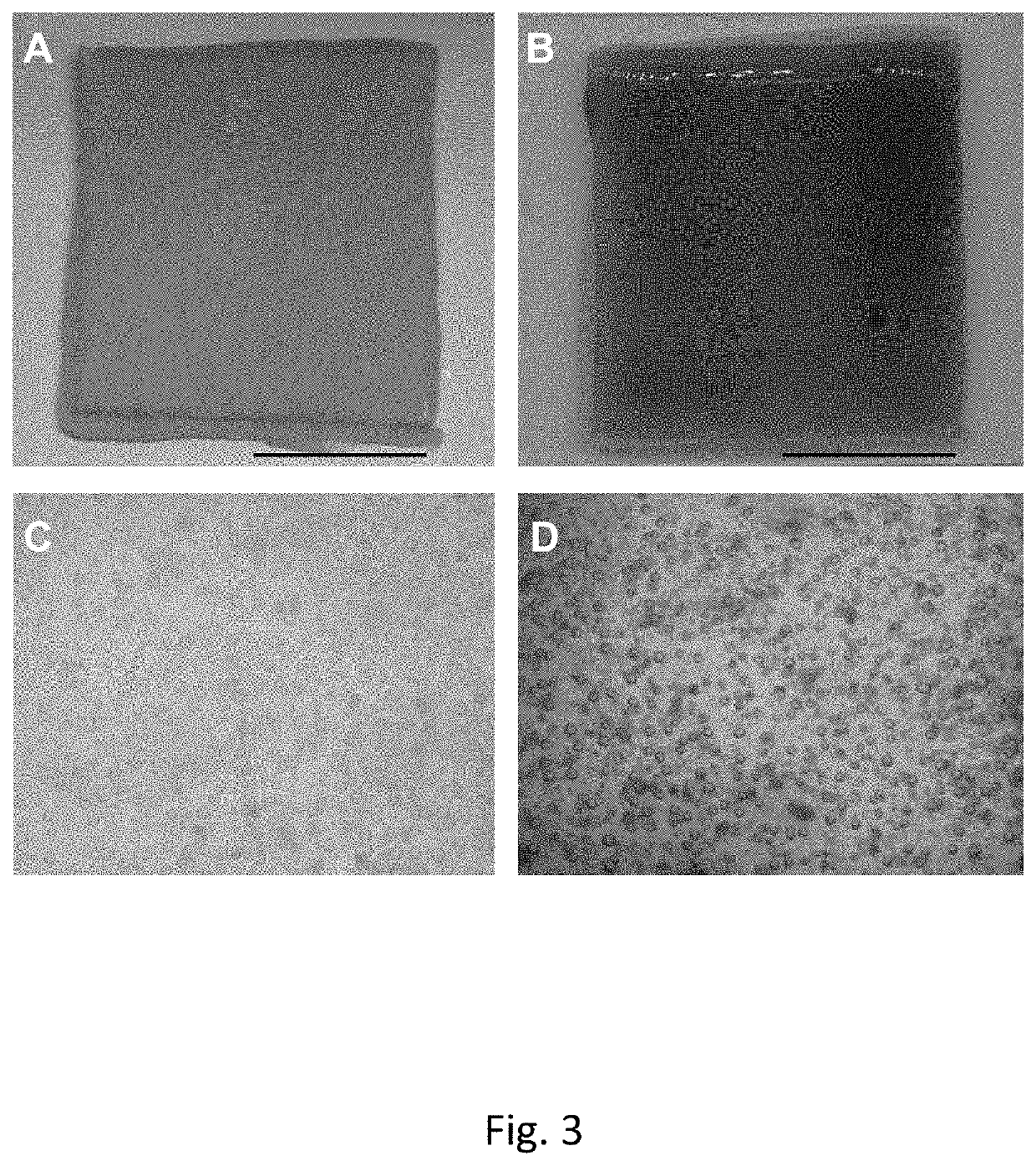Oxygen-releasing biomaterials, articles and methods
a biomaterial and oxygen-releasing technology, applied in the direction of aerosol delivery, prosthesis, microcapsules, etc., can solve the problem that solid peroxides can introduce potential risk of uncontrollable burst release of oxygen, and achieve the effects of accelerating wound healing, improving healing, and quick and easy administration
- Summary
- Abstract
- Description
- Claims
- Application Information
AI Technical Summary
Benefits of technology
Problems solved by technology
Method used
Image
Examples
example 1
nerating Biomaterials
Materials
[0047]Polycaprolactone (PCL) pellets were acquired from Capa, Fischer Scientific. Calcium peroxide (CaO2) was supplied by Sigma Aldrich. Porcine Skin Gelatin 100 g was purchased from Sigma Aldrich. Methacrylic anhydride was obtained from Sigma-Aldrich (St. Louis, Mo.). Dulbecco's phosphate buffered saline (DPBS), Dulbecco's Modified Eagle's Medium (DMEM—low glucose), fetal bovine serum (FBS), trypsin-ethylenediaminetetraacetic acid (EDTA) 0.25%, and penicillin / streptomycin (P / S) were purchased from Gibco (Thermo Fisher Scientific, Inc., Waltham, Mass.). Alamar Blue reagent was obtained from Invitrogen (Grand Island, N.Y.). 2-hydroxy-1-[4-(hydroxyethoxy) phenyl]-2-methyl-1propanone (Irgacure 2959) was acquired from BASF Corporation (Florham Park, N.J.). Lactate Dehydrogenase (LDH) activity kit was obtained from Genesee Scientific. Caspase glo 3 / 7 assay kit was secured from Promega. NeoFox Oxygen sensing probe was procured from Ocean Optics Inc. All reage...
example 2
issue
Materials
[0082]Polycaprolactone (PCL) pellets were purchased from Fischer Scientific. Calcium peroxide (CaO2) was purchased from Sigma Aldrich. Porcine Skin Gelatin 100 g was purchased from Sigma Aldrich. Methacrylic anhydride was obtained from Sigma-Aldrich (St. Louis, Mo.). Dulbecco's phosphate buffered saline (DPBS), Dulbecco's Modified Eagle's Medium (DMEM—low glucose), fetal bovine serum (FBS), trypsin-ethylenediaminetetraacetic acid (EDTA) 0.25%, and penicillin / streptomycin (P / S) were purchased from Gibco (Thermo Fisher Scientific, Inc., Waltham, Mass.). Alamar Blue reagent was purchased from Invitrogen (Grand Island, N.Y.). 2-hydroxy-1-[4-(hydroxyethoxy) phenyl]-2-methyl-1propanone (Irgacure 2959) was purchased from BASF Corporation (Florham Park, N.J.). Lactate Dehydrogenase (LDH) activity kit was purchased from Genesee Scientific. Caspase glo 3 / 7 assay kit was purchased from Promega. NeoFox Oxygen sensing probe was purchased from Ocean Optics Inc. All reagents were use...
example 3
neration
Materials
[0140]Polycaprolactone (PCL) was obtained from Fischer Scientific. Calcium peroxide (CaO2) was supplied by Sigma Aldrich. Porcine skin gelatin 100 g was acquired from Sigma Aldrich. Methacrylic anhydride (MAA) was obtained from Sigma-Aldrich (St. Louis, Mo.). Dulbecco's phosphate buffered saline (DPBS), Dulbecco's Modified Eagle's Medium (DMEM—low glucose), fetal bovine serum (FBS), trypsin-ethylenediaminetetraacetic acid (EDTA) 0.25%, and penicillin / streptomycin (P / S) were purchased from Gibco (Thermo Fisher Scientific, Inc., Waltham, Mass.). Alamar Blue reagent was obtained from Invitrogen (Grand Island, N.Y.). 2-hydroxy-1-[4-(hydroxyethoxy) phenyl]-2-methyl-1propanone (Irgacure 2959) was acquired from BASF Corporation (Florham Park, N.J.). Lactate Dehydrogenase (LDH) activity kit was purchased from Genesee Scientific. Caspase glo 3 / 7 assay kit was procured from Promega. NeoFox Oxygen sensing probe was purchased from Ocean Optics Inc. All reagents were used as rec...
PUM
| Property | Measurement | Unit |
|---|---|---|
| diameter | aaaaa | aaaaa |
| hydrophobic | aaaaa | aaaaa |
| biocompatible | aaaaa | aaaaa |
Abstract
Description
Claims
Application Information
 Login to View More
Login to View More - R&D
- Intellectual Property
- Life Sciences
- Materials
- Tech Scout
- Unparalleled Data Quality
- Higher Quality Content
- 60% Fewer Hallucinations
Browse by: Latest US Patents, China's latest patents, Technical Efficacy Thesaurus, Application Domain, Technology Topic, Popular Technical Reports.
© 2025 PatSnap. All rights reserved.Legal|Privacy policy|Modern Slavery Act Transparency Statement|Sitemap|About US| Contact US: help@patsnap.com



